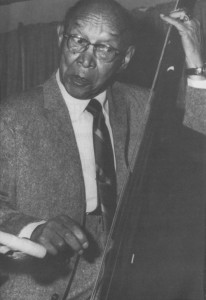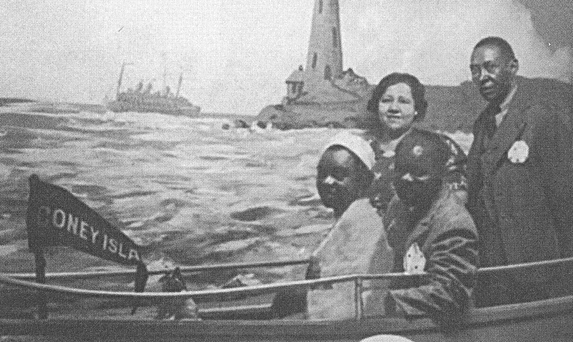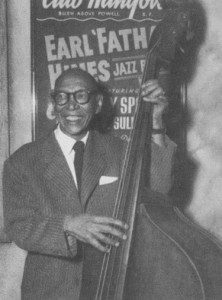
Pops Foster at Club Hangover, San Francisco, 1956. Photo from The Autobiography of Pops Foster, New Orleans Jazzman, by Tom Stoddard.
Pops Foster often said, "I'm just another bass player trying to make a living." Yet over a seven decade career New Orleans jazzman George ‘Pops’ Foster's solid bass fiddle playing provided the beat for jazz legends from 'King' Oliver to Charlie Parker.
A pioneer of the string bass at a time when tuba was more commonly used in rhythm sections outside New Orleans, Pops remarked, "The string bass is best for swinging the band. On tuba, you hit a note, man, and it's gone. A tuba never did fit in no orchestra, but they tried to make 'em."
It was Pops Fosters' 1929 Okeh record backing Louis Armstrong on "Mahogany Hall Stomp" that put string bass on the map in jazz. String bass had been commonly used in New Orleans but in New York it was a different story. Pops said, "Man, I was ashamed to carry my bass in New York 'cause I couldn’t go more than a block without people laughing at me. Every bass player in town was playing tuba in the 20s."
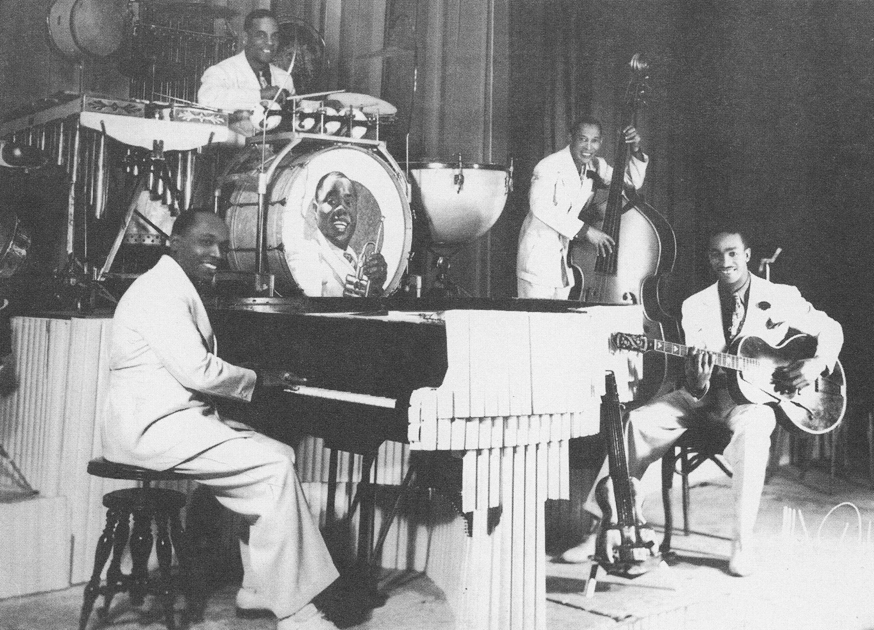
Rhythm section of the Louis Armstrong Orchestra, about 1936. From left: Luis Russell, piano; Paul Barbarin, drums; Pops Foster, bass; Lee Blair, guitar. Photo from The Autobiography of Pops Foster, New Orleans Jazzman by Tom Stoddard.
Foster's hard-driving approach to jazz rhythm first gained widespread national attention during his time as a key member of the Luis Russell Orchestra of the late 1920s and early 1930s, the band with which Louis Armstrong made his most celebrated recordings of that era. In The Autobiography of Pops Foster, New Orleans Jazzman by Tom Stoddard, Bertram Turetzky notes that Pops' four-beat, wide, booming rhythm style was widely adopted in New York. Pops said, "...when I went to New York playing that way, everybody wanted to do it, too. Right after that...about 1929 or 1930...they started writing arrangements that way, with a four-to-the-bar bass part."
The experience of hearing Pops Foster live—'rompin' the big fiddle'—was often transforming for the listener. Swing Era bass legend Bob Haggart put it this way:
"[The} big chomping sound Pops Foster got out of a bass was a driving force and inspiration to me for many years. There was a primitive quality to this sound which appealed to me and it played a large part in my background and influenced my concept of bass playing..."
This week on Riverwalk Jazz Pops Foster tells his own story in rare archival interviews, and actor Vernel Bagneris portrays Pops in scenes from his autobiography. He was a modest man with a giant talent, and only late in life did Pops Foster put himself forward to play improvised jazz solos on the bass. His infectious, relentless beat drove the band and got dancers out of their seats and onto the floor.
From Congo Square to the Monterey Jazz Festival, Pops Foster was witness to a vast panorama of jazz history. He worked with King Oliver in New Orleans, and in St. Louis he played with Charlie Creath’s Jazz-O-Maniacs. He toured California in the early 20s with Kid Ory. He ate barbecue and played music with Bix on the road in Illinois. In New York he recorded with Fats Waller and Jelly Roll Morton. And a half century into his career in the 1950s he became an important figure in the West Coast Classic Jazz Revival and a regular appearing with Earl Hines at the Club Hangover in San Francisco.
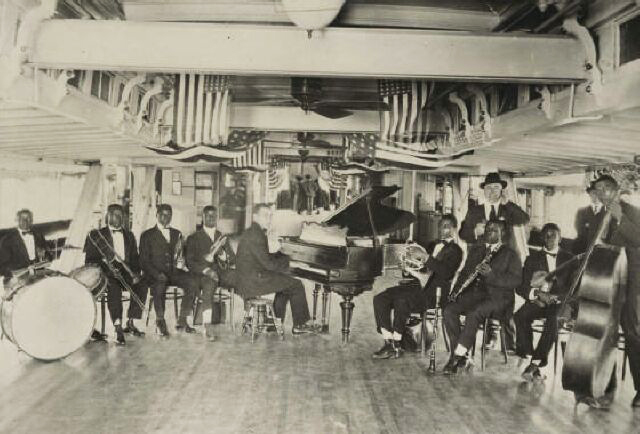
Fate Marable's New Orleans Band on the S.S. Sidney, circa 1919. From left: Baby Dodds, drums; Bebe Idgley, trombone; Joe Howard, trumpet; Louis Armstrong, trumpet; Fate Marable, piano; Dave Jones, mellophone; Johny Dodds, clarinet; Johnny St. Cyr, banjo; Pops Foster, bass Photo courtesy tulane.edu
One constant in Pops’ career was his friendship with Louis Armstrong. Pops said that in the very early days in New Orleans, "the onliest thing Louis could play was the blues—and he played ‘em good, too." The summer of 1919 saw them both performing on the Streckfus line in the first black band to play on Mississippi riverboats.
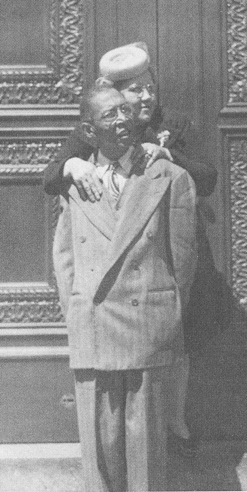
Pops & Alma Foster, 1945 Boston. Photo from The Autobiography of Pops Foster, New Orleans Jazzman, by Tom Stoddard.
In 1930s New York Pops and Louis were band mates in Luis Russell’s Orchestra—a top New York dance band that would morph into a star vehicle for Louis Armstrong. And when Pops Foster married Alma, the love of his life, Armstrong and his wife stood up for them.
Pops often said that Alma was the "best thing that ever happened to me." He said the reason he "live so long wasn't because I took good care of myself, I didn’t. It was because I was lucky enough to find a good wife—my Alma." They were together for almost 40 years.
Photo credit for Home Page: Pops Foster, courtesy sftradjazz.
Text based on Riverwalk Jazz script by Margaret Moos Pick ©2011


